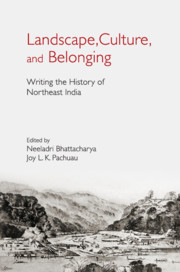Book contents
- Frontmatter
- Contents
- List of Figures
- Acknowledgements
- Introduction
- I Borders and Beyond
- 1 India's Spatial History in the Brahmaputra–Meghna River Basin
- 2 The Birth of the Ryot: Rethinking the Agrarian in British Assam
- 3 Embracing or Challenging the ‘Tribe’? Dilemmas in Reproducing Obligatory Pasts in Meghalaya
- II Surveys and Explorations
- III Ethnography, History, and the Politics of Representation
- IV Law, State, and Practices of Governance
- V Cultural Dialogues
- Notes on Contributors
- Index
2 - The Birth of the Ryot: Rethinking the Agrarian in British Assam
from I - Borders and Beyond
Published online by Cambridge University Press: 26 April 2019
- Frontmatter
- Contents
- List of Figures
- Acknowledgements
- Introduction
- I Borders and Beyond
- 1 India's Spatial History in the Brahmaputra–Meghna River Basin
- 2 The Birth of the Ryot: Rethinking the Agrarian in British Assam
- 3 Embracing or Challenging the ‘Tribe’? Dilemmas in Reproducing Obligatory Pasts in Meghalaya
- II Surveys and Explorations
- III Ethnography, History, and the Politics of Representation
- IV Law, State, and Practices of Governance
- V Cultural Dialogues
- Notes on Contributors
- Index
Summary
Students of South Asian history are a little too familiar with the category of ryot; so familiar, indeed, that few pause to reflect on the critical ideological labour that went into making it appear as a transparent, self-evident, economic term. Usually considered a colonial officialese for peasant, the word is reported to have been ‘taken from the Mughal lexicon to denote an individual tax-paying property owner who had a receipt for revenue payments that constituted an official title to land, a pattah’. Held in the embrace of an Indianist frame, the category continues to be used in Assam history without much reflection on the particular series of epistemological and institutional works that it was made to perform in the northeastern frontier. In this article, through a close reading of early nineteenth-century official documents, I direct attention at some of these specific tasks that came to delineate the template of the ryot in the frontier. In introducing this ‘Mughal’ term to a territory supposedly inherited from the ‘Ahoms’, the British officials responded to quite distinctive historical processes and made important political choices regarding labour, ethnicity, and cultures of rule. It is my contention that instead of taking the ryot as the degree zero of British Assam's agrarian history, a critical genealogy of the category will be more helpful in understanding the politics of agriculture in the frontier.
This politics is most visibly spatial. The forging of an agrarian landscape is not only a matter of altering physical terrains, but also one of determining legal topographies, fiscal jurisdictions, and fields of identity. In early British Assam, the categorial autonomy of ryots was crucially defined in simultaneous opposition to ‘tribes’ and ‘slaves’. As surplus-producing, plough-using, gainfully labouring, sedentary peasants, the ryots were routinely depicted as the evolutionary winners against the hand-to-mouth, slashing-and-burning, nomadic, almost pre-productive tribes. As individual, tax-paying, plot-bound smallholders working at their own will, they were proudly touted as the real beneficiaries of civilizational progress under imperial rule in contradistinction to the wretched and oppressed lot of local slaves. In the cartographies of these imagined worlds, the place of the ryot was the primary site of the emergent liberal subject.
- Type
- Chapter
- Information
- Landscape, Culture, and BelongingWriting the History of Northeast India, pp. 38 - 65Publisher: Cambridge University PressPrint publication year: 2019

